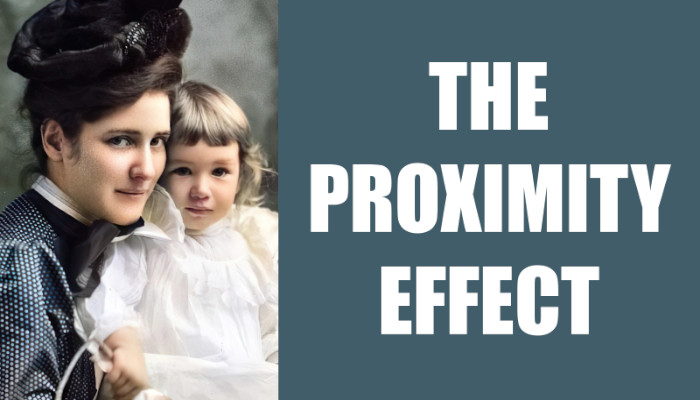
The fifth post in a series on metaphor
Sound engineers know that the closer something is to a microphone, the fuller its sound. Known in the music industry as the Proximity Effect, the phenomenon results in microphones capturing more of a close source’s low frequency tones (think James Earl Jones) than it’s higher frequency cousins (think Mickey Mouse).
We’ve all experienced the Proximity Effect. As babies, we learned to associate close sounds with intimate moments. Consider a mother holding her baby while singing a soft lullaby. From the baby’s perspective, not only is her voice warmed by the Proximity Effect, but it’s doubly-enhanced with the even bassier vibrations from within her chest.
Now consider Mom leaning close and whispering into the baby’s ear. Think about how distance affects a whisper. A soft whisper next to one’s ear sounds rich and full, while that same whisper a few feet away sounds thin and glassy. Or, from the Mom’s perspective, imagine the difference between her baby cooing right next to her ear and hearing that same coo from across the room. The first is intimate. The second is cute.
Yet, that’s only the positive side of lower frequencies. Close Mom whispers and baby coos are perceived as positive because they are wanted. When those low frequencies aren’t wanted, however, they can signal danger. Consider the two unsettling notes that define the movie Jaws. Dah-Dum. Dah-Dum.
The effect that proximity has on our perceptions is best summed up by the metaphor: Proximity is Power. The closer an entity is to us, the more power it’s perceived to have. If a close object is wanted, the power has a positive effect. If it’s unwanted, however, proximity can be interpreted as a threat. As a result, an entity’s perceived power can be interpreted as either protective or dangerous.
Close entities have an unfair advantage over us because their relative importance is inversely proportional to distance. An object miles away is of little significance, yet that same object inches away demands our total attention–to the exclusion of anything else around us.
Because the concept of proximity and power is so universally understood, it’s an effective tool to use when trying to explain something’s relevance. The next time you need to convey a concept’s vitality, consider incorporating proximity into your explanation. Ask yourself, “How can I express this thought using the metaphor: Proximity is power? How can I use the multi-dimensional concept of closeness, whether it be physical, emotional, temporal, or relational to make my point?”
Photo Credit: C.M. Bell, photographer. Fraser, Mrs. & baby., 1894. [between February and February 1901] Photograph. https://www.loc.gov/item/2016697211/.